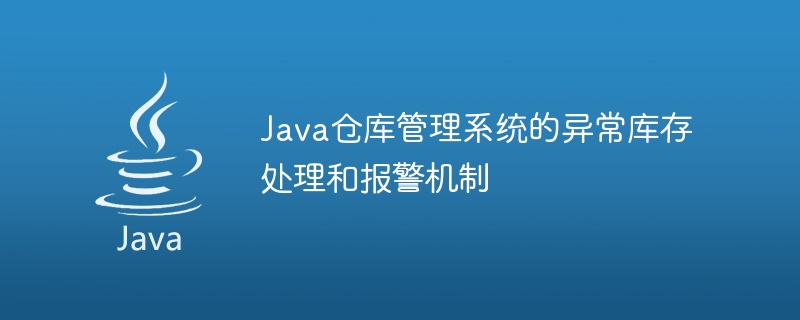

Abnormal inventory processing and alarm mechanism of Java warehouse management system
With the rapid development of e-commerce, warehouse management has become an indispensable part of e-commerce enterprises . The efficient operation of the warehouse management system is crucial to the development of the enterprise. In daily operations, the warehouse management system may face various abnormal situations, one of which is inventory abnormality. In this article, we will explore how to use Java to write an abnormal inventory processing and alarm mechanism for a warehouse management system, and give specific code examples.
1.1 Inventory Count
Regular inventory counting is one of the important means to troubleshoot abnormal inventory. In the warehouse management system, we can write a functional module for inventory counting. This module will traverse all the goods in the warehouse, calculate the actual inventory, and compare the actual inventory with the system recorded inventory. If abnormal inventory is found, the system should record the abnormal information and handle it accordingly.
The following is a code example for inventory counting:
public class InventoryManager {
public void doInventoryCheck() {
List<Product> products = getAllProducts();
for (Product product : products) {
int actualStock = calculateActualStock(product); // 计算实际库存
int recordedStock = getRecordedStock(product); // 获取系统记录库存
if (actualStock != recordedStock) {
handleStockDiscrepancy(product, actualStock, recordedStock); // 处理异常库存
}
}
}
// 其他方法的实现省略...
}1.2 Abnormal inventory processing
When abnormal inventory is discovered, we need to handle it in a timely manner. How this is handled depends on the cause and impact of the abnormal inventory. The following are some common ways to deal with abnormal inventory:
1.2.1 Data Repair
If the abnormal inventory is caused by errors in inventory data entry, we can repair the data and make corresponding adjustments. For example, fix inventory quantity errors, update product status, or adjust inventory alarm values, etc.
1.2.2 Product transfer or replenishment
If the abnormal inventory is caused by damage or loss of the product, we may need to transfer the product or replenish the product. This can be achieved through collaboration with suppliers or other warehouses. After allocation or replenishment, we should update the inventory in a timely manner and ensure that the system records are consistent with the actual inventory.
The following is a code example for handling abnormal inventory:
public class InventoryManager {
public void handleStockDiscrepancy(Product product, int actualStock, int recordedStock) {
if (actualStock > recordedStock) {
adjustStock(product, actualStock - recordedStock); // 商品调拨
} else if (actualStock < recordedStock) {
replenishStock(product, recordedStock - actualStock); // 商品补货
}
updateRecordedStock(product, actualStock); // 更新系统记录库存
logStockDiscrepancy(product, actualStock, recordedStock); // 记录异常库存信息
}
// 其他方法的实现省略...
}The following is a code example of an alarm mechanism:
public class InventoryManager {
private static final int LOW_STOCK_THRESHOLD = 10; // 库存报警阈值
public void checkStockLevel(Product product) {
int currentStock = getCurrentStock(product);
if (currentStock <= LOW_STOCK_THRESHOLD) {
sendStockAlert(product, currentStock); // 发送库存报警
}
}
private void sendStockAlert(Product product, int stock) {
String message = "商品 " + product.getName() + " 的库存已经低于预期,当前库存为 " + stock;
// 发送报警通知至相关人员
}
// 其他方法的实现省略...
}In the warehouse management system, inventory exceptions and alarm mechanisms are very important functions. By writing code examples in Java, we can better understand and implement these functions. Of course, this is just a simple example, and actual warehouse management systems will be more complex. However, I hope this article will help you understand the abnormal inventory processing and alarm mechanism of the warehouse management system.
The above is the detailed content of Abnormal inventory processing and alarm mechanism of Java warehouse management system. For more information, please follow other related articles on the PHP Chinese website!
 How to restart regularly
How to restart regularly
 Windows cannot access the specified device path or file solution
Windows cannot access the specified device path or file solution
 What is the difference between 5g and 4g
What is the difference between 5g and 4g
 Remove header line
Remove header line
 oracle insert usage
oracle insert usage
 How to restore IE browser to automatically jump to EDGE
How to restore IE browser to automatically jump to EDGE
 How to start mysql service
How to start mysql service
 What is the difference between css framework and component library
What is the difference between css framework and component library




